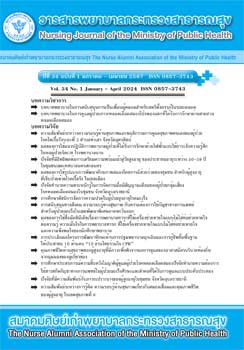ปัจจัยทำนายความตระหนักรู้ในการจัดการเมื่อมีสัญญาณเตือนของผู้ป่วยกลุ่มเสี่ยงโรคหลอดเลือดสมองในชุมชน จังหวัดอุบลราชธานี
Main Article Content
บทคัดย่อ
ผู้ป่วยกลุ่มเสี่ยงโรคหลอดเลือดสมอง มีโอกาสเกิดหลอดเลือดตีบ แตก หรืออุดตันในเวลาใดก็ได้ ดังนั้น ผู้ป่วยกลุ่มเสี่ยงโรคนี้จึงควรมีความตระหนักรู้เพื่อขอความช่วยเหลือได้อย่างทันเวลา การศึกษาครั้งนี้เป็นการวิจัยแบบศึกษาความสัมพันธ์เชิงทำนาย เพื่อศึกษาความตระหนักรู้และปัจจัยทำนายความตระหนักรู้ในการจัดการเมื่อมีสัญญาณเตือนโรคหลอดเลือดสมองของผู้ป่วยกลุ่มเสี่ยงโรคหลอดเลือดสมองในชุมชน กลุ่มตัวอย่างคือ ผู้ป่วยกลุ่มเสี่ยงโรคหลอดเลือดสมองในจังหวัดอุบลราชธานี จำนวน 160 คน เครื่องมือที่ใช้ในการรวบรวมข้อมูล ประกอบด้วย แบบสอบถามข้อมูลทั่วไป แบบสอบถามการรับรู้เกี่ยวกับปัจจัยนำ ปัจจัยเอื้อ และปัจจัยเสริมเกี่ยวกับโรคหลอดเลือดสมอง และแบบสอบถามความตระหนักรู้ในการจัดการเมื่อมีสัญญาณเตือนของโรคหลอดเลือดสมอง เครื่องมือวิจัยผ่านการตรวจสอบคุณภาพความตรงเชิงเนื้อหาจากผู้เชี่ยวชาญ มีค่า CVI เท่ากับ .86, .94, .75 และ 1.0 ตามลำดับ และค่าความเชื่อมั่น เท่ากับ .77, .88, .75 และ .76 ตามลำดับ วิเคราะห์ข้อมูลโดยใช้สถิติพรรณนาและการวิเคราะห์ถดถอยพหุคูณแบบเป็นขั้นตอน ผลการวิจัยพบว่า ความตระหนักรู้ในการจัดการเมื่อมีสัญญาณเตือนโรคหลอดเลือดสมองของผู้ป่วยกลุ่มเสี่ยงโรคหลอดเลือดสมองในชุมชน อยู่ในระดับสูง ปัจจัยนำด้านการรับรู้โอกาสเสี่ยงต่อการเป็นโรคหลอดเลือดสมอง และปัจจัยเสริมด้านแรงสนับสนุนจากเจ้าหน้าที่สาธารณสุข สามารถร่วมกันทำนายความตระหนักรู้ในการจัดการเมื่อมีสัญญาณเตือนโรคหลอดเลือดสมองของผู้ป่วยกลุ่มเสี่ยงในชุมชนได้อย่างมีนัยสำคัญทางสถิติ คิดเป็นร้อยละ 25.00 (R2=.25, p<.05) ผลการวิจัยครั้งนี้บ่งชี้ว่าเจ้าหน้าที่ทางสุขภาพควรมีการสื่อสารให้ผู้ป่วยกลุ่มเสี่ยงให้รับรู้ถึงโอกาสเสี่ยงในการเกิดโรคและส่งเสริมความตระหนักรู้ในการจัดการเมื่อมีสัญญาณเตือน ทั้งนี้เพื่อช่วยให้ผู้ป่วยได้รับการรักษาได้อย่างทันเวลาซึ่งจะเป็นการลดอัตราเสียชวิตและทุพพลภาพของผู้ป่วยโรคหลอดเลือดสมองได้
Article Details

อนุญาตภายใต้เงื่อนไข Creative Commons Attribution-NonCommercial-NoDerivatives 4.0 International License.
บทความและรายงานวิจัยในวารสารพยาบาลกระทรวงสาธารณสุข เป็นความคิดเห็นของ ผู้เขียน มิใช่ของคณะผู้จัดทำ และมิใช่ความรับผิดชอบของสมาคมศิษย์เก่าพยาบาลกระทรวงสาธารณสุข ซึ่งสามารถนำไปอ้างอิงได้
เอกสารอ้างอิง
World Health Organization. World Stroke Day 2022 [Internet[. 2022 [cited 2022 Dec30] Available from https://www.who.int/srilanka/news/detail/29-10-2022-world-stroke-day-2022.
National Institute for Emergency Medicine. Situations and trends in health and emergency medicine (global and Thailand) [Internet].2022 [cited 2022 Nov 19] Available from http://www.niems.go.th/ 1/UploadAttachFile/2022/Ebook/414764_20220208161448.pdf.
Pesungnoen A, Suwonroop N, Pinyopasakul W. Factors predicting stroke prevention behaviors in patients at risk in primary care units. The Journal of Baromarajonani College of Nursing, Nakhonratchasima. 2018;24(1):41-56.(in Thai)
Wongsa D, Soivong P, Chaiard J. Quality of among stroke persons within six months post diagnosis. Nursing Journal. 2018;45(2):40-50.(in Thai)
Doungthipsirikul S, Wachiradilok P, Sirisamud T. The study of the emergency medical service situation and the development of emergency operation quality in stroke patients Report. National Institute for Emergency Medicine.2022.(in Thai)
Khantichitr P, Sanchaisuriya P, Thepphawan P. Time-to-treatment of stroke patients: experience from Ubon Ratchathani Province. Thailand. Journal of Health Systems Research 2016;10(3):277–88. (in Thai)
Suriya M, Siriruay M, Lekphet J, Soisungnoen T, Deeraksa S. Time to access and referral of stroke patients in Thakhuntho Hospital Thakhuntho District, Kalasin Province. Mahasarakham Hospital Journal 2020;17(3):140–7.(in Thai)
Pancioli AM, Broderick J, Kothari R, et.al. Public perception of stroke warning signs and knowledge of potential risk factors. JAMA 1998;279(16):1288–92.
Breckler SW. Attitude structure and function. Hilladate NJ: L.Erlbaum Association. 1986.
Wanna A, Kimsungnoen N, Namjuntra R. Perceptions and management of warning signs among persons at risk of stroke. APHEIT Journal of Nursing and Health 2020;2(1):30-44.(in Thai)
Korjedee P, Kittiboonthawal P, Namdej N, Chunchum J. A Predictive factors of the knowledge levels with stroke risk factors and warning signs in Saraburi community people. Nursing Journal of the Ministry of Public Health 2022;32(2):65-77.(in Thai)
Tanan R, Kompayak J, Srikhaw O. Awareness of stroke warning signs management among patients with high-risk hypertension. HCU Journal and Health Science 2018;22(43-44):13-26.(in Thai)
Sonti A, Noppakhun T, Duangchan C. factors influencing early hospital arrival among acute ischemic stroke patients in Hua Hin Hospital. Journal of Prachomklao College of Nursing, Phetchaburi Province 2022;5(3):24-38.(in Thai)
Kunlana K, Srisanpang P, Panpanit L, Tiamkao S. Factors related to treatment of stroke in patients with acute ischemic stroke in a tertiary hospital, Ubon Ratchathani Province. North-Eastern Thai Journal of Neuroscience 2021;13(1):31-43.(in Thai)
Kamsareeruk J, Jitpanya C. Factors related to prehospital time in patients with acute ischemic stroke 2015;7(2):106-19.(in Thai)
Ua-Kit N, Pensri L. Utilization of the PRECEDE MODEL in health promotion. Thai Red Cross Nursing Journal 2019;12(1):38-48.(in Thai)
VanVoorhis CW, MorganBL. Understanding power and rules of thumb for determining sample size. Tutorials in Quantitative Method for Psychology. 2007;3(2):43-50.
Best, J. Research in education. New jersey:Prentice-Hall.1981.
Rosenstock IM, Stretcher VL, Becker MH. Social learning theory and the health belief model. Health Education Quarterly 1998;15(2):175-183.
Komton V. Stroke patients’s self-management: application of empirical evidence. Journal of Thailand Nursing and Midwifery Council 2019;34(1):25-41.(in Thai)

